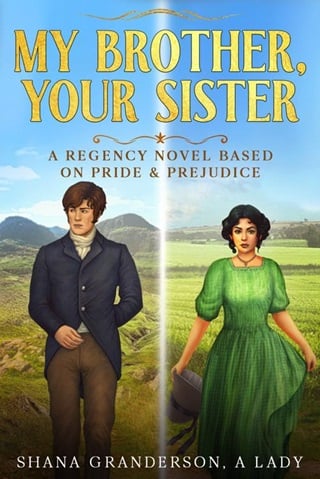Epilogue
Woburn Abbey, June 1820
As they had for the three years since their husband and father had passed away, his wife, the Dowager Duchess of Bedford, his son, the Duke of Bedford, adopted son, Saul Rhys-Davies Bennet, and his daughters, Viscountess Hilldale and Lady Elizabeth Darcy visited his crypt in the family section below the Woburn Abbey church on the anniversary of the late Sedgewick Rhys-Davie’s death.
The four joined their mother to honour the late husband and father. It was one occasion their spouses did not join them thus allowing the core family members to remember the late duke in private. The grandchildren, led by the eldest of them, Julia who was thirteen, had their own rituals to remember Grandpapa Sedgewick.
Rose stood with her sons either side of her, each one holding a hand, and her daughters next to one of their brothers. A few tears escaped as she mourned the love of her life. Even after three years since his passing, she still wore the muted colours of half mourning, as she was determined to do for the rest of her days until she was called home and would be in her beloved’s company once again.
After he passed, Rose had considered giving up so she could hasten the time when she would join her Sedgewick. She had heard his voice in her head forbidding her to act in such a way. The voice reminded her how much she had to live for— children, grandchildren, and a large extended family who loved her. She had promised her husband she would live a full life and would join him when it was her ordained time and not before.
In June of 1817, feeling as if he was not up to travel, even the little more than fifty miles into Surrey, the Duke had urged his wife to join the Darcys and not miss their youngest’s third lying in due to a trifling summer cold. Hence, Rose had honoured her husband’s wishes and joined the Darcy parents as they continued their way to Surrey.
It was on this day three years ago, that the late duke succumbed to a rather virulent bout of influenza.
~~~~~~~/~~~~~~~
Although she still felt a certain level of guilt that she was not home when her beloved Sedgewick had taken ill, Rose had been at Rivington for the birth of Elizabeth and William’s third child—the long awaited daughter. Anne and Robert Darcy had collected Rose on their way to attend Elizabeth and their grandsons at the beginning of June 1817.
Elizabeth and William were more in love than the day they had married. With two such stubborn people, there were disputes, but as both had made a solemn vow never to go to bed angry, they relished in the making up after a disagreement. At least over the years William was able to best his wife and father-in-law at chess about a third of the time. Against his brothers-in-law, Saul and Philip, he won, but only occasionally.
The younger Darcys had been gifted with a son, Bennet Robert in April 1810. Robert Thomas arrived in the world in January 1814. Ben was a smaller version of his father, dark hair, piercing blue eyes, tall, and rather stoic. Robby was similar to his father in looks, except for his mother’s emerald-green eyes, and he most definitely had her outgoing character.
The three sets of grandparents, Great-grandmama Beth, and many uncles and aunts had been present for the two Darcy boys births.
During that visit, Anna-Rose Frances Darcy had joined the family in June of 1817. All of the grandparents, except for the ailing duke, and many of Elizabeth’s sisters and brothers had been present to welcome Anna-Rose into the world.
Elizabeth and William were blessed with a second daughter in December 1819. They named her Francene Anne, to be called Franny by everyone.
John Biggs and Brian Johns were employed by the Rivington Darcys where they had moved the day of the wedding in March 1809. They kept an eye on the Darcy children, and any others who happened to be with them, like huge, benevolent uncles. It was not unheard of for some of the younger boys to beg to be lifted up to the shoulders of the two giant sized men, who almost never refused them.
~~~~~~~/~~~~~~~
On that journey from Woburn Abbey in June 1817, the Darcys and Rose had, as was always done when any of the family was travelling near Hertfordshire, made a stop at Longbourn and Netherfield Park for a few days.
Saul and his wife, the former Maria Lucas, were by then the master and mistress of the estate. Bennet and Fanny had handed the estate over to them when Saul turned five and twenty. The Bennet patriarch and matriarch spent a large portion of the year travelling to spend a month or two at a time with their daughters and grandchildren.
Netherfield Park had become Philip’s property in March 1815. He lived there with his wife, Giana, and their children. Like Hampton Downs would go to a second son, or a daughter if there was no second son, of Giana and Philip Bennet, the estate Saul had been gifted from his adoptive family, would eventually belong to his and Maria’s second son.
~~~~~~~/~~~~~~~
Fanny and Bennet, along with Beth Bennet, were more than happy in Longbourn’s dower house. In fact, they shared it with Sir William and Sarah Lucas. Around the time Bennet turned Longbourn over to Saul, Sir William had wanted to do the same with Lucas Lodge for Franklin, who had married the older Long niece, and his family. With Maria the new mistress of Longbourn and the amount of time Fanny and Bennet spent at the estates and homes of their other children, they proposed sharing the large dower house. After verifying it would not put the Bennets out, Sir William and Lady Lucas accepted the offer.
There had been a major loss for the Bennet family in September 1818. Beth Bennet had gone to sleep one night, already past the age of eighty, and never woke again. The whole of the family—she had been a great-grandmother to all of the new generation, regardless if related to her by blood or not—mourned her for a full six months, but at the same time they celebrated the life of a wonderful woman. Elizabeth had had a special bond with Grandmama Beth until the end.
~~~~~~~/~~~~~~~
By the time Saul and Philip graduated from Cambridge, between them they had demolished all of Bennet’s records, except for the most consecutive wins. Their father, rather than being upset his sons had replaced him in the record books, was inordinately proud of their achievements.
Even though Cathy and Maria were a year older than Giana and Lydia, the four had begged their respective parents, who had agreed, that they come out at the same time. Hence they had their come out in February 1813. At the time Cathy and Maria were already eighteen, and approaching the age of nineteen, Giana would be eighteen in March, and Lydia would reach the same age in September.
It was an open secret that Saul and Philip were besotted with Maria and Giana respectively, however, they waited for some months after the girls came out to declare themselves to the lady with whom each was in love. They had begun with courtships followed by engagements in February 1814, a year after the two came out.
Like many of their major events in life, they celebrated jointly. The twins were married to their respective wives in a joint ceremony in May 1814. As one bride hailed from Derbyshire and the other from Hertfordshire, and the extended families of the brides and grooms involved mostly lived close to the two home shires of the brides, it had been agreed that the wedding would be held at Woburn Abbey.
Anne and Robert Darcy always hoped they would see Giana marry from Pemberley, but they did not want to cause the twins to marry in separate ceremonies separated by more than a hundred miles, so they had graciously agreed to Bedfordshire for the location of the wedding.
Maria had delivered a son in June 1815; he had been named Thomas William after two of his three grandfathers. Not to be out done, Giana birthed her son, Paul Robert, in August 1815. By early in 1819, the sisters by marriage each had a second child, Maria had delivered a second son while Giana had gifted Philip with a daughter.
~~~~~~~/~~~~~~~
By the time the Darcy parents, Rose, and the group from Longbourn and Netherfield Park arrived at Rivington to be with Elizabeth for her lying in, Jane, Richard, and their children were already present.
With the proximity between Rosings Park and Rivington, not many days passed that the Fitzwilliams and Darcys were not visiting at one estate or the other when they were both home. The close relationship between the four adults had only deepened over the years. Just like Jane and Elizabeth, and Richard and William who were respectively as close as sisters and brothers by blood, similarly, the children of the two couples were more like brothers and sisters.
Emily and Sed, Belle and Andrew, and Matlock and Elaine arrived at Rivington a few days later. They intended to make for their estates for the summer after Lizzy delivered.
~~~~~~~/~~~~~~~
Jane and Richard had a much more serene relationship than the Darcys. However, when Jane needed to assert her will, she had no problems doing so. Almost every day Richard asked himself how he had won the heart of the wonderful woman to whom he was married. Rosings Park had never had a better master and mistress. Each year, Jane and Richard hosted the whole of the family, and some friends like the Hursts, for Easter at Rosings Park.
Just as Jane had suspected, she had in fact been with child at Lizzy’s wedding. It seemed she took after her mother because she birthed twins at the end of August 1809, but unlike her younger brothers, they were a boy and a girl. Elaine Frances, Ellie, had been born twenty minutes before Thomas Reginald. Even now that they were ten, Ellie never missed an opportunity to let Tom know he was her younger brother.
Three years after the twins, Bethany Mary joined the family. A little less than three years later another daughter was born, Kathleen Lydia, Katie to her family and friends, Almost four years after that, the youngest, Saul Philip arrived.
Ellie liked to point out to her Darcy and Bennet cousins she was older as well, but as she matured, she did that less and less. Tom could not wait until she outgrew the habit altogether. With her cousins Julia and Rosie, Ellie never seemed to mention their relative ages.
Emily and Sed were gifted with a second daughter in November 1810, and then three sons, born in early 1813, mid-1815, and December 1818. By the time the late Duke of Bedford passed away, he knew that the dukedom was safe and had met two of his three grandsons. The heir, the new Marquess of Birchington, was of course named Sedgewick like all dukes in the line before him.
After Rosie, who even at thirteen, as did all of the children in the family, loved to have Aunt Lizzy tell her stories, Belle and Andrew were blessed with two sons and a second daughter. The boys were born in January 1810, and October 1813, while their sister joined the family in May 1816.
With his being spry, Reginald Fitzwilliam had not slowed down very much. He enjoyed a lively debate in the Lords, and although he had gradually turned the running of the ancillary Matlock estates’ over to Andrew, he still managed Snowhaven. Elaine revelled in all of her grandchildren, both by blood and the ones—which was all of the younger generation—who had adopted her, Rose, Cilla, Anne, Fanny, and the relevant husbands as their grandparents as well.
Holder planned to turn Holder Heights over to Jamey and Charlotte before summer of 1821. He was still in full health, but he and Cilla decided they preferred spending time with the cadre of grandchildren—both by blood and adopted—more than running the Holder estates. The Lords was the remaining obligation Holder would have once he installed his son and daughter-in-law at Holder Heights. Cilla had no complaints as it allowed them more time with their children, grandchildren, and the rest of the family.
It had been almost two years before Charlotte bore a babe. A son was born in September 1810. William Paul was named for his two grandfathers and called Will. In June 1812, the first of two daughters was born, the second arriving in May 1816. When it was suspected Charlotte’s days of increasing were over, she had begun to increase in early-1819. A second son, named Gregory for his late uncle, had entered the world on the final day of 1819.
~~~~~~~/~~~~~~~
Three of Elizabeth’s sisters had not been able to join the family for the birth of the third Darcy child in 1817. Mary, Cathy, and Lydia were all too close to their own lying ins.
If word reached Rivington that Fanny and Jane were needed by one of them before Elizabeth gave birth, both would be on their way. Maddie Gardiner and Hattie Philips, as well as Cathy’s and Lydia’s mothers-in-law were already with the three younger Bennet sisters.
Mary was waiting to deliver her third child and the youngest two Bennet sisters, their first.
~~~~~~~/~~~~~~~
It was no surprise to anyone when George Wickham proposed to Mary in December 1810, a few days after she turned nineteen. To say he was flabbergasted when he discovered he had been accepted by an heiress with close to forty thousand pounds, was an understatement. It was only after he had been accepted by Mary that Philips shared all of the Bennets’ files, including those pertaining to dowries and their true wealth, with George Wickham.
They had married at the end of January 1811, neither wanting to wait too much longer. Their wedding settlement stipulated that Mary’s dowry remained under her control. Lucas Wickham had been the proudest of fathers the day he witnessed his son marrying for love. He thanked God every day that George had made meaningful changes to his life all those years in the past.
With the money George had saved over the years and some gifted to the couple by his father, Mary’s parents, the Darcys, and some of her aunts and uncles, the Wickhams were able to purchase a large, comfortable house on the outskirts of Meryton which sat on twenty acres of land. Mary, who had learned gardening from her mother, was beyond pleased she had more than enough room to plan extensive gardens and that there would be sufficient parkland for their children to play in, not to mention stables for ponies and horses.
Their first son, Lucas George, was born in September 1813, followed in August 1815 by a daughter. Mary and George cared not what their third child would be, as long as she or he was healthy, and the same for Mary in George’s mind. Mary had given birth to a second daughter six weeks after Elizabeth in 1817, and then another son was born in October 1819.
Frank Philips retired from the practice of law in March 1814 and happily turned his practice over to his Wickham nephew. In the six years at the helm, George had grown the practice and taken on four clerks and one additional solicitor for all of the work from towns and areas near, and some not so near, to Meryton.
Lucas Wickham retired as Pemberley’s steward in June 1815 and was invited to come live with his son and daughter-in-law. He gratefully accepted.
~~~~~~~/~~~~~~~
Cathy and Lydia had enjoyed three seasons until the former was one and twenty and the latter just barely twenty. Cathy had met Lord Wes De Melville, Viscount Westmore, at various events, but had not detected any interest from him, and she had not thought they would fit.
In Cathy’s final season as a single woman, the two began to spend more and more time in company and it soon became evident he was most certainly interested in her and she was anything but indifferent to him. He proposed in February 1815, and they were married by mid-May of that same year.
She had followed her mother and Jane and three weeks after Lizzy delivered, Cathy and Wes had been blessed with twin sons, who like their uncles, were close to identical as they grew. Lord Cyril and Lady Sarah De Melville, the Earl and Countess of Jersey, were delighted their daughter-in-law had delivered twins as they were the first set in the known history of her or his family.
In November 1819, Cathy brought a daughter into the world.
The biggest surprise of all was when Lydia accepted a proposal from William Bennet, who by then held both the livings of Longbourn and St. Alfred’s in Meryton.
After he had resigned the name Collins and taken his cousins words to heart, William Bennet had become the man he was meant to be. He had allowed his intelligence to come to the fore and had become a clergyman any parish would be blessed to have. As Bennet had promised, when Mr. Pierce retired, his cousin was preferred to the living at the Longbourn Village church.
William Bennet had become so popular in the area that when the rector of St. Alfred’s retired in 1812, he had been awarded that living as well.
Over the years, his relationship with the Bennets and the extended family had gone from strength to strength, and notwithstanding the more than ten years between them, he and Lydia had become very good friends.
He knew he had fallen in love with Lydia, but did not think she saw him as more than a friend or an elder cousin. He had been unaware that Lydia had fallen in love with him. It had come on so gradually that she had been in the middle before she knew she had begun. She was able to divine William was in love with her, so she gave him a pointed hint or two in January 1815.
She and Cathy were married in a double ceremony.
The happy result of Lydia’s first lying in was, in fact, twin daughters only a week after Mary’s daughter was born. The twins were joined two years later by a younger brother.
~~~~~~~/~~~~~~~
Madeline and Edward Gardiner had retired to a small estate near Lambton in June 1818. By then Gardiner had felt confident in his son Eddy’s ability to run the business and he was ably assisted by the husbands of Lilly and May. Peter, who would graduate from Oxford in three years, planned to join the business as well.
The house on Berkeley Square was used by Lilly and her husband, but Eddy and Peter kept rooms there. Eddy had just begun to court a young lady.
~~~~~~~/~~~~~~~
Over the years Louisa and Harold Hurst were included in any celebratory events of the extended family. They lived most of the year at Winsdale, and thanks to the proximity to Rivington and Rosings Park, they and their two sons and a daughter, were closest to those who lived at the two named estates.
A few years after Charles and Caroline arrived in New South Wales, the former (using a secretary) began to write to Louisa. With her brother’s owning of his multiple errors, they rebuilt their relationship, via correspondence across the seas.
~~~~~~~/~~~~~~~
The only surviving villain, Horace Kimble, the former Baron Epsom, met the Bingleys in New South Wales. Bingley had some thriving businesses and had married the daughter of Major-General Forster, the man commanding the garrison.
Miss Caroline Bingley was as yet not married, and Kimble—who used his former title to impress ladies—had marked her to be his wife as she had a dowry of twenty thousand pounds. She was enamoured with the prospect of marrying a baron, even if no one in London would ever know of her triumph. Unfortunately for him, and fortunately for Caroline Bingley, the Duke of Bedford’s agents informed Bingley, that the man was stripped of his title. He was further told that other than what was remaining of two thousand pounds he had been given when he was banished from England, tghe man had nothing to his name. All was related to his sister who cut Kimble the next time she saw him.
As the truth of his situation became widely known, Kimble found all the doors of society in Sydney shut to him. He left to try finding a friendlier town away from New South Wales and was thankfully never heard from again.
When she was eight and twenty, Miss Bingley finally married…the man was a tradesman.
~~~~~~~/~~~~~~~
Word had arrived with a courier, that her husband was severely ill a week after Elizabeth had given birth to her daughter in June 1817. Rose, Sed, Belle, Saul, their wives and children, and as much of the extended family who was able to, arrived at Woburn Abbey just in time to say goodbye to the ailing duke.
~~~~~~~/~~~~~~~
Once Rose and her children had all said their silent prayers for her late husband, they made the short walk back towards the manor house. They stopped on a little rise overlooking the park near the one side of the mansion.
There were a few large tents set up for shade, chairs, tables, blankets, and pillows spread around as a picnic was being held for all of the extended family who were present at the Abbey.
With a wide smile on her face, Elizabeth watched the running children, her beloved spouse watching their children, their youngest in his arms, her Bennet parents, the other grandparents, adopted siblings, and all the other family members.
She turned to her mother, Sed, Belle, and Saul. “I care not who was my brother or your sister, we are simply one very large family,” Elizabeth stated as she watched the tableau on the well-manicured lawn.
“Never a truer word was spoken, Sister,” Saul agreed.
The five walked down the incline to join the rest of the family.
~~~The End~~~
 Fullepub
Fullepub 



